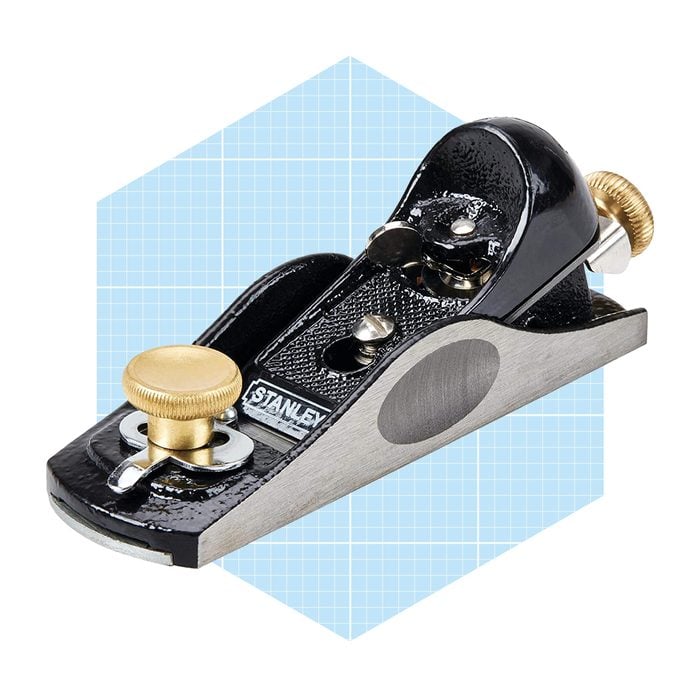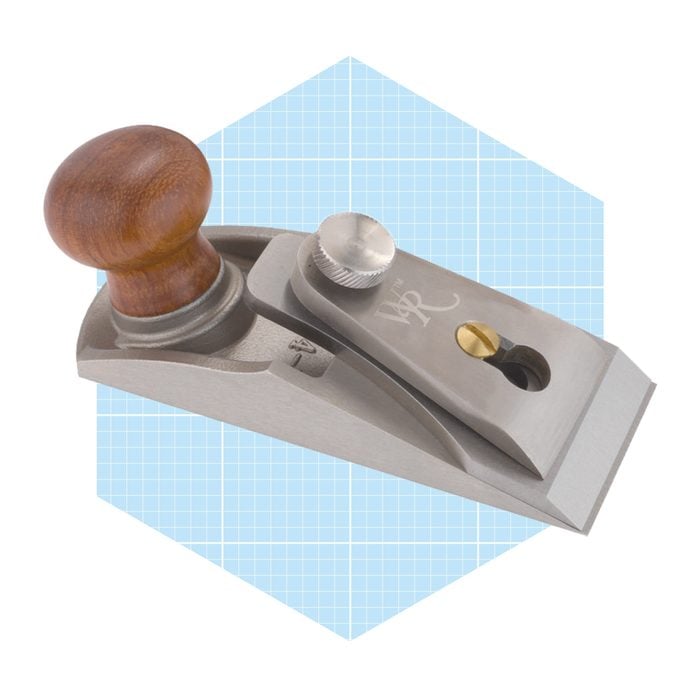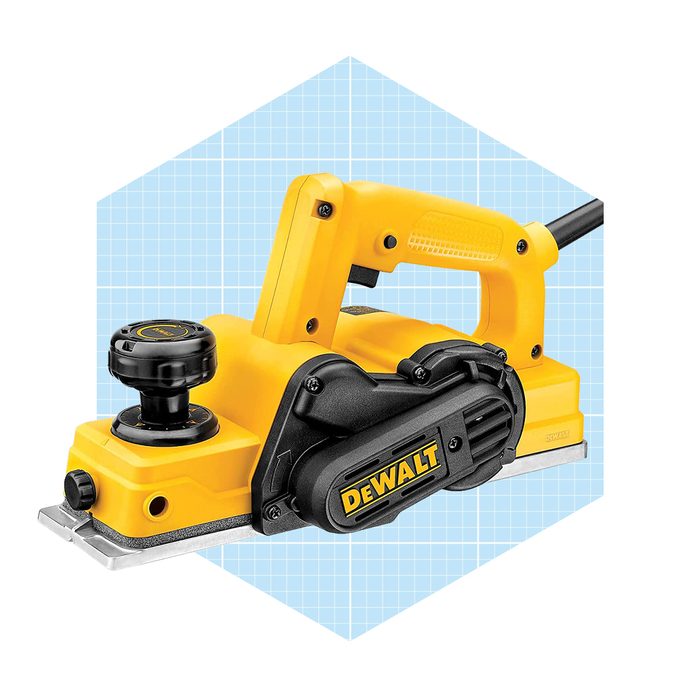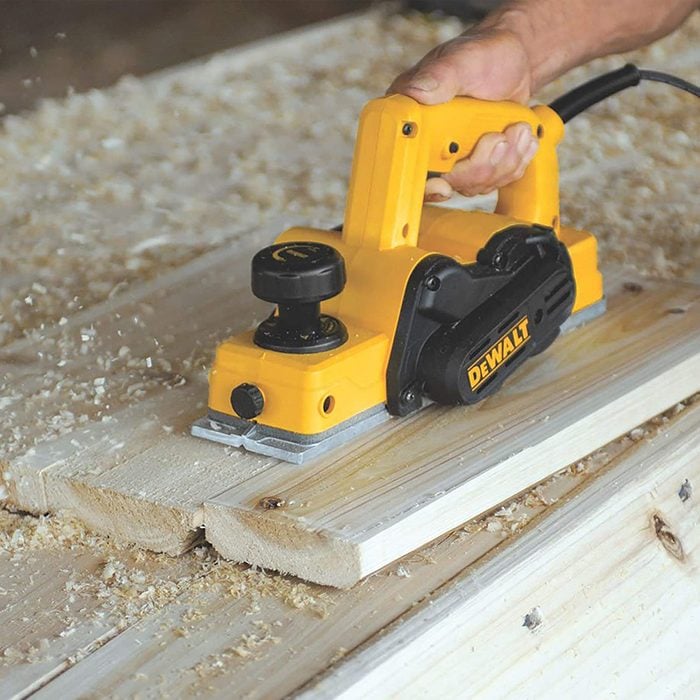
Best All Purpose Planer
The block plane is a handy tool for breaking and chamfering board edges, straightening studs, removing milling marks and fine-tuning wooden drawer slides.
The heavy-duty Stanley Six-Inch Low Angle Block Plane is accurate and dependable. Featuring a 21-degree bed angle, it’s ideal on a variety of construction materials and trimwork. Its cast-iron base, machined side and bottom and hardened steel blade ensure accurate cuts every time. Dialing it in perfectly takes time, but the effort will be quickly rewarded.
Type: Block.
Length: Six inches.
Bevel: Up.
Cutting iron width: 1.375-inches.
Pros
- Inexpensive;
- Durable;
- Great entry level plane.
Cons
- Takes time to dial in;
- Performs best in softwoods.

Best For Tight Spaces
As the name implies, a chisel plane consists of a cutting edge on an angled wedge, with depth adjustment to control the cut. It’s perfect for removing excess glue, trimming dowels or plugs and flush-cutting edge banding.
The Wood River Chisel Plane features a durably cast stainless body and low-alloy carbon steel blade. It’s a small and compact tool you’ll uses for more than light trimming and adhesive removal. Hands down, it’s the most-used plane in my shop.
Type: Chisel.
Length: Five inches.
Bevel: Up.
Cutting iron width: 1.75-inches.
Pros
- Compact;
- Versatile;
- Needs little initial adjusting.
Cons
- Non-protected blade;
- Expensive.

Best Splurge Plane
It’s nearly impossible not to feel some romanticism when using a long, two-handed jack plane to smooth out rough-sawn lumber.
I like the Stanley Sweetheart Low Angle Jack Plane. Stanley crafted the nearly 14-inch plane from versatile, air-hardening A2 tool steel for optimal edge retention. A one-piece precision ground frog and base casting and American Cherry knob and handle create a comfortable fit. And it’s made by a company that’s been around for more than 150 years.
This is probably the most expensive non-power tool I own. But for smoothing and jointing short boards and overall ease of use, bevel-up jack planes are the best.
Type: Jack.
Length: 13.77-inches.
Bevel: Up.
Cutting iron width: Two inches.
Pros
- Easy to use;
- Versatile;
- Comfortable;
- Accurate, high-quality tool.
Cons
- Expensive.

Best Electric Planer
It takes a lot of time and energy to flatten any large project with a hand plane. With a tool like the DeWalt 3-1/4-Inch Power Hand Planer that spins at 34,000 revolutions per minute (rpm) and can cut up to 1/16-in. deep, these types of tasks can be completed in no time.
It features parallel machined aluminum shoes, a calibrated adjustment knob and an automatic kickstand that lets you set the planer on the work surface without damaging it. Plus, if sharpening isn’t your forte, power planer blades are inexpensive. Unless of course, you wish to upgrade to reversible carbide blades, which will provide a longer blade life and a better finish. Learn how to use an electric planer.
Type: Electric.
Length: 15-1/2-inches.
Bevel: N/A.
Blade width: 3-1/4-inches.
Pros
- Automatic kickstand;
- Edge chamfering groove in base;
- Affordable replacement blades.
Cons
- Noisy;
- Messy. Dust collection port not included.
Types of Hand Planes
There are numerous hand planes out there, all with specified uses. For the sake of simplicity, let’s break down hand planes into five categories:
- Block planes: A compact, smaller hand plane generally used single-handed. These bevel-up planes produce a near 45-degree cutting angle when combining the cutting iron bevel and bed angle. Ideal for many general purpose tasks.
- Bench planes: A two-handed plane, usually made of steel, with a hardwood front knob and handle (tote). Fore, jack, smoothing and jointing planes are types of bench planes, found in bevel-up and bevel-down constructions. Longer bench planes are typically used for straightening, and the shorter ones for smoothing.
- Specialty planes: These fit a specific type of woodworking task. Examples include rabbet, shoulder, chisel and finger planes. Many specialty planes disappeared from the market after power tools became available, like fiberboard-specific and circle cutting planes.
- Japanese planes: These resemble traditional wooden planes, with one major difference — they cut on the pull stroke rather than the push. In most cases, they’re made entirely of wood except for their bevel down cutting irons. Available in various sizes and configurations.
- Power/electric plane: A power planer is similar to a jointer found in a woodworking shop. Both tools feature a cutter head mounted between an infeed and an outfeed bed or shoe that can be precisely adjusted to determine the depth of cut. Power planes are best suited for projects where large quantities of wood need to be flattened or joined. Though they provide the speed needed for a large undertaking, they’re messy and lack the qualities that traditional hand planes bring.
What to Consider When Choosing the Best Hand Plane
- Type: What are your needs? If it’s joining long board edges, go with a jointer plane. Pick up a trim plane for breaking board edges. If you’re not sure, I suggest a bench plane.
- Length: This is primarily a factor in joining or straightening boards. In general, the longer the plane, the straighter the results.
- Bevel: The sloping angle of a hand plane. There are two types of hand planes, with bevels that face up or down. On a bevel down plane, the iron’s cutting angle is the bed angle. However, on a bevel up plane, the cutting angle is the bed angle plus the bevel angle. Therefore, a bevel up plane with a bed angle of 20 degrees and a cutter bevel of 25 degrees produces a 45-degree cut angle.
- Cutting iron width: This determines how much material you’re cutting with each pass. A wide range of values exist here, ranging from 5/16-in. on a finger plane to nearly 3-in. on some Japanese planes. Even wider outliers exist.
- Price: Antique hand planes are sold at auction, often for tens of thousands of dollars. Hand planes you’d actually use in your shop can range from less than $50 to nearly $500. Generally, higher-priced planes are made with better tool steel alloys and have a finer tolerance for casting and machining.
How Do Hand Planes Work?
Made of wood or metal with a flat base, hand planes work like a cheese grater. They hold a cutting iron or blade at a specific angle to shave down wood.
Set the blade depth prior to use, holding a small portion of the blade’s beveled edge below the flat base of the plane. When you push or pull the sharpened cutting iron over the wood, the blade slices the wood fibers, leaving a smooth, flat path. After several repeated strokes, the wood becomes level and smooth.

